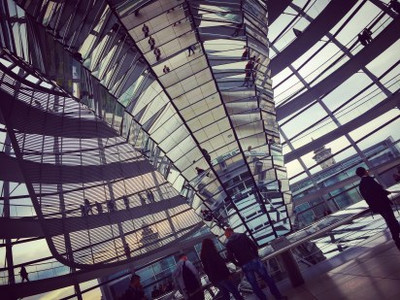CARRY ON CAMPING – BERLIN
- Steven Anderton

- Jan 26, 2018
- 4 min read
Updated: May 11, 2020
Berlin, the capital of Germany, a city which to many is most famously known for its division by the Berlin wall from 1961 to 1989. Berlin’s vast and unique history has shaped the city and to this day is still under huge change and redevelopment. The second most populous city in the European Union after London, Berlin is a buzz of activity and hugely deserving of its reputation as a cosmopolitan and diverse world-class city.
Situated in the south-eastern part of Berlin, is the most recent “hipster” neighbourhood of Neukölln. Often referred to as “Little Istanbul” due to its large immigrant population, particularly Turkish, the neighbourhood benefits from this multicultural demographic, brimming with cool eateries, nightlife and eclectic shopping.
Neukölln’s new found reputation has attracted the artsy ‘cool kids’ and subsequently is in the midst of a boom, largely thanks to the closure of the Tempelhof airport. Now this might seem a little ironic that a closure of one of the world’s largest transport hubs actually made property prices soar but now the old runways form part of Tempelhofer Feld. This 386 hectare park and social space plays host to many cultural events such as 'The Berlin Festival'
It seems only fitting for such an individual neighbourhood, to play home to the über cool Huttenpalast. This isn’t your run of the mill hotel though, oh no, this hotel is true Berlin style at its best.
In a prominent position within Neukölln with easy transport links via the underground and a stones throw from Tempelhof Feld, Huettenpalast is the creation of Silke Lorenzen and Sarah Vollmer. The ladies had a plan, a plan to create a hotel, but not a hotel in the classical sense, they were creating one their way!
After searching for just the right building in the neighbourhood they call home, they settled upon an old factory that was just waiting to be reawakened with their vision.
The former vacuum cleaner factory building was transformed into the hotel, garden and café Huettenpalast. Guests can choose between staying in the two halls which house caravans and lodges in a communal setting or private hidden factory rooms.
HALLE ONE
Walking through the café and out into the courtyard garden, the first stop was Halle One. Inside this industrial space are three vintage caravans and three cabins, each one totally individually designed. The concept is for communal living, a place to be shared with a large group of friends or a nice way to interact with fellow guests, like camping with no mud…winner!
Starting with the ‘Little Sister’ this 1970’s caravan designed by Yoraco Gonzales, was given a ‘top hat’ to enable guest to stand up inside. Within this roof canopy guests can look up and not only see stars but flowers, sea horses and musical notes. To contrast with the plastic of the caravan the inside is finished in a wooden mosaic, whilst outside the caravan is surrounded by birch trees and cosy seating areas; perfect to enjoy the complimentary morning coffee and croissants.
One of my favourite “rooms” was the ‘Heartbreaker’ caravan. Built in 1959 by Karosseriebau Nagetusch in Dresden, this iconic caravan was a labour of love for Sarah and Silke. When they first got the caravan, it was in a sorry state but with a lot of love and careful restoration it was brought back to life and now features the original wood paneling mixed with circus style accessories.
If the caravan idea isn’t your bag, sat at the focal point of the hall are the original production rooms of the factory, accessed through a sliding door. Inside ornate one hundred year old wood panels from the original room were luckily saved and now guests can stay within this space named the ‘Old Palace’ cabin.
The 'Old Palace' sleeps up to four people, two downstairs and two on the roof. The interior was designed by French artist, Marion Andrieu, who contrasted the historical front of the cabin with graphic patterns and bold colours.
HALLE TWO
In the second hall there are five caravans and one cabin. At the centre of the hall is ‘The Egg’, a 1930’s classic from the DDR times and named due to its unique shape. This caravan was on Sarah and Silke’s wish list and was added as an addition after the initial opening.
The Egg uniquely sits on stilts and enables guests to have an elevated view of the hall. Walking up the stairs the caravan has a beautiful mix of wooden veneer on the outside, whilst inside the double bed is surrounded by classic retro 1930’s style wallpaper.
The cosy little 1950’s ‘Puck’ is another favourite of mine. Styled in collaboration with designer Sebastian Feucht, 'Puck' experienced the biggest transformation of all the caravans. When Sarah and Silke received 'Puck', it was just an aluminium shell, which they have brought back to life in true 1950’s style. Inside, the bright orange colour scheme is contrasted with the white ‘bubble’ style ceiling, whilst the kitchen area was removed to enable more space for the double bed.
The variety and uniqueness of each “room” is what really impressed me, from the space age theme of ‘the 1960’s ‘Fridel’ to the cuteness of ‘Snow White’ the smallest of all the caravans and made from plywood. In the 1960’s plywood was purposefully used to ensure the caravan was light enough for the famous Trabant car to handle it.
Famous Berlin street artist Nomad, whose work is spread throughout the city, even put his stamp on a 1960’s caravan. Inspired by a recent trip to Africa, at the 2011 'Berlin Festival', Nomad painted the caravan in voodoo style symbols and pop art to create a 3-D masterpiece.
If the thought of staying in these amazing caravans isn’t your thing, which quite frankly I cant see why, then Huettenpalast offers private hidden hotels rooms within the factory building.
To me though, why stay in a regular hotel room when you can sleep in an elevated 1930’s caravan shaped like an egg?!






































































Comments